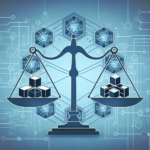Understanding Quantum Computing and Its Implications
The Basics of Quantum Computing
Quantum computing is a revolutionary approach to computation that harnesses the principles of quantum mechanics. Unlike classical computers that process data in binary using bits (0s and 1s), quantum computers use quantum bits, or qubits. Qubits can exist in multiple states at once, thanks to superposition, allowing quantum computers to perform complex calculations at speeds that far surpass traditional computers.
Current Cryptographic Systems at Risk
Most modern encryption methods, such as RSA and ECC (Elliptic Curve Cryptography), rely on mathematical problems that are computationally hard for classical computers to solve. However, quantum computers have the potential to crack these systems rapidly using algorithms like Shor’s algorithm, which can factor large numbers efficiently. This jeopardizes the security of sensitive information, including financial records, personal data, and state secrets.
Challenges in Building Quantum-Resistant Systems
Transitioning from Classical to Quantum-Resistant Algorithms
One of the main challenges in developing quantum-resistant systems is transitioning from existing cryptographic algorithms to post-quantum cryptography (PQC) algorithms. This requires a significant overhaul of systems that are already in place, which can be expensive and time-consuming.
Compatibility with Existing Infrastructure
Many organizations rely on established cryptographic protocols. Ensuring that new quantum-resistant solutions are compatible with existing systems is crucial. An ideal PQC algorithm should seamlessly integrate into current systems without extensive modifications or disruptions.
Performance and Scalability Issues
Quantum-resistant algorithms often require larger key sizes or more complex computations compared to their classical counterparts. This can lead to issues with performance and scalability in real-world applications. For example, in environments where high-speed transactions are critical, the added computational load could cause significant slowdowns.
Efficiency in Resource-Limited Environments
In scenarios such as IoT (Internet of Things) where devices have limited processing power and memory, implementing heavy cryptographic algorithms can be impractical. The challenge lies in developing lightweight versions of quantum-resistant algorithms that maintain security without overburdening the devices.
Standardization of Quantum-Resistant Algorithms
The standardization process for quantum-resistant algorithms is another significant hurdle. Organizations like NIST (National Institute of Standards and Technology) are working on developing and standardizing PQC algorithms, but this process takes time and scrutiny. Untested or unproven algorithms pose risks, as their security might not be adequately validated.
Solutions to Overcome Challenges
Adopting Hybrid Cryptographic Systems
One potential solution to the challenges of transitioning to quantum-resistance is the adoption of hybrid cryptographic systems. By combining traditional algorithms with quantum-resistant alternatives, organizations can enhance their security while maintaining compatibility with existing infrastructure.
Gradual Implementation
A hybrid approach allows for gradual implementation, where existing systems continue to function while incorporating quantum-resistant algorithms incrementally. This mitigates risk and reduces the operational disruptions that a complete overhaul might cause.
Investing in Research and Development
A concerted effort in research and development can lead to significant advancements in the field of quantum-resistant algorithms. Academia, industry leaders, and governments must collaborate to share knowledge and resources, paving the way for innovative solutions.
Exploring Lightweight Cryptography
Focus on lightweight algorithms that cater specifically to resource-constrained environments is necessary. Investing in R&D for compact and efficient quantum-resistant algorithms can provide a path to integrating quantum security in IoT and other limiting contexts.
Continuous Monitoring and Updating
The landscape of cybersecurity is ever-evolving, and organizations must remain vigilant. Regular assessments of cryptographic systems should be conducted to identify vulnerabilities and ensure they adapt to new threats from quantum computing.
Establishing a Cybersecurity Framework
Developing a proactive cybersecurity framework that incorporates a risk-based approach is essential. Organizations should involve stakeholders from different departments to ensure everyone is aligned and aware of the emerging threats posed by quantum computing.
Education and Training
Educating stakeholders, employees, and decision-makers about quantum computing and its implications for security is crucial. Awareness of emerging technologies allows organizations to adopt quantum-resistant strategies proactively.
Developing Skilled Workforce
Building a workforce equipped with knowledge of quantum cryptography is a long-term investment. Collaborations with academic institutions and training programs can help in fostering skills focused on developing and applying quantum-resistant technologies.
Future Directions in Quantum-Resistant Technology
Continued Evolution of Algorithms
As quantum computing technology advances, so must the algorithms to counter its effects. Continuous research will bolster the development of more robust and efficient quantum-resistant algorithms, ensuring that they can withstand the evolving capabilities of quantum computers.
Exploring New Mathematical Foundations
Shift from traditional algorithmic bases to exploring new mathematical constructs may lead to more secure options. Researchers should investigate alternative techniques such as lattice-based, hash-based, and code-based cryptography to enhance security.
Collaboration Across Industries
The transition to quantum-resilient systems requires collaboration among various sectors. Tech companies, government institutions, and academic bodies must work hand in hand to identify challenges, share knowledge, and develop solutions beneficial to all.
Global Initiatives for Standardization
Global initiatives can help streamline the standardization process for quantum-resistant algorithms. By creating overarching frameworks that encourage compliance and cooperation, we can accelerate the transition to more secure cryptographic practices.
Building Trust and Assurance in New Systems
Finally, building trust in newly developed quantum-resistant systems is paramount. Clear communication about the security features, vulnerabilities, and benefits can help stakeholders understand and adopt these technologies enthusiastically.
Open-Source Communities
Encouragement of open-source contributions goes a long way in developing credible and reliable quantum-resistant solutions. Collaborative platforms can help build community trust, making it easier for organizations to adopt and rely on these solutions.
In conclusion, while there are significant challenges in building quantum-resistant systems, innovative approaches and collaborative efforts can pave the way for more secure digital communication in the future. Through education, research, and strategic planning, we can tackle these obstacles and emerge stronger in the age of quantum computing.








